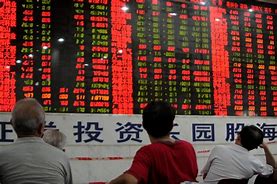The Bessent short has gained popularity as the US and China descend into a trade war.
It's grounded in the famous Soros Fund Management short of the British pound.
But are there signs that this could be happening to the Yuan?
Let's explore the Bessent short 🧵:
It's grounded in the famous Soros Fund Management short of the British pound.
But are there signs that this could be happening to the Yuan?
Let's explore the Bessent short 🧵:

First let's explore the dynamics that Bessent exploited shorting the pound.
• UK joined ERM, a system design to stabilize European currency
• Britian was in a recession
• This conflicted with the principle of currency stabilization
But how was Bessent was key to the scheme?
• UK joined ERM, a system design to stabilize European currency
• Britian was in a recession
• This conflicted with the principle of currency stabilization
But how was Bessent was key to the scheme?

Bessent joined Soros Fund Management in 1991, quickly rose to the head of the London office and part of Soros inner circle by 1992.
Scott was an expert in the UK's weaknesses.
He provided the research and analysis that Soros and Stanley Druckenmiller used to execute the short.
Scott was an expert in the UK's weaknesses.
He provided the research and analysis that Soros and Stanley Druckenmiller used to execute the short.

What was in the research brief?
• 90% of UK mortgages were tied to overnight interest rate
• With UK in recession the Bank of England was forced to maintain high rates to defend the ERM peg
• Rising rates to support the pound would crush homeowners and the broader economy
• 90% of UK mortgages were tied to overnight interest rate
• With UK in recession the Bank of England was forced to maintain high rates to defend the ERM peg
• Rising rates to support the pound would crush homeowners and the broader economy

This macro-level research complemented the broader macroeconomic thesis that Soros and Druckenmiller were developing.
Bessent acted as the "eyes and ears" for Soros’s operation in Europe.
His proximity to the UK market allowed him to gather real-time insights.
Bessent acted as the "eyes and ears" for Soros’s operation in Europe.
His proximity to the UK market allowed him to gather real-time insights.

How was the trade executed?
Soros built a massive short position, starting with $1.5 billion and scaling to $10 billion.
A trigger came when Bundesbank's Schlesinger implied no German support for the pound.
Soros then dramatically increasing his short position overnight.
Soros built a massive short position, starting with $1.5 billion and scaling to $10 billion.
A trigger came when Bundesbank's Schlesinger implied no German support for the pound.
Soros then dramatically increasing his short position overnight.

The BoE attempted to prop up the pound via foreign reserves (£3.3 billion in losses) and raising interest rates twice.
These measures failed as speculators, led by Soros, overwhelmed the market with sales.
The BoE’s reserves were finite making the defense untenable.
These measures failed as speculators, led by Soros, overwhelmed the market with sales.
The BoE’s reserves were finite making the defense untenable.

So, are there signs that Bessent is running a short on China?
Has he already established a controlling position in the dynamic?
If so, how did that happen?
Let's explore...
Has he already established a controlling position in the dynamic?
If so, how did that happen?
Let's explore...

Let's start at the beginning.
The keys to any effective leverage trade are research, stealth and timing.
We will start with the timing.
• 11/5/24 Trump elected
• 11/11/24 China announces their market holidays for 2025
• 11/22/24 Trump announce Bessent nomination
The keys to any effective leverage trade are research, stealth and timing.
We will start with the timing.
• 11/5/24 Trump elected
• 11/11/24 China announces their market holidays for 2025
• 11/22/24 Trump announce Bessent nomination

These events are more significant than the seem.
Trump and Bessent were strategizing a pressure campaign on the Chinese Yuan from the start.
Trump knew Bessent's history and intended to use his expertise.
This goal made the Chinese holiday schedule important.
Trump and Bessent were strategizing a pressure campaign on the Chinese Yuan from the start.
Trump knew Bessent's history and intended to use his expertise.
This goal made the Chinese holiday schedule important.

By setting his announcement to April 2, Trump ensured US traders would have two full days of trading before the Chinese could fully respond.
The Chinese market traded in the aftermath of Trump's tariff announcement, closed at 3 AM EST Thursday and wouldn't reopen until Monday.
The Chinese market traded in the aftermath of Trump's tariff announcement, closed at 3 AM EST Thursday and wouldn't reopen until Monday.

What do we mean by stealth?
Much like the bomber, you don't want the enemy to know they're being attacked until it's too late.
Trump said that he'd be announcing finely tuned reciprocal rates.
Instead on 4/2 he dropped a nuke, rates over 30% based on made up formulas!
Much like the bomber, you don't want the enemy to know they're being attacked until it's too late.
Trump said that he'd be announcing finely tuned reciprocal rates.
Instead on 4/2 he dropped a nuke, rates over 30% based on made up formulas!

The news media screamed that this wasn't what they were told.
The markets immediately and unexpectedly crashed.
A random X account solved the mystery of how Trump arrived at the announced rates.
Some said this was a total screw up and blamed Lutnick.
Confusion reigned!
The markets immediately and unexpectedly crashed.
A random X account solved the mystery of how Trump arrived at the announced rates.
Some said this was a total screw up and blamed Lutnick.
Confusion reigned!

The goal was accomplished.
China was unexpectedly facing a massive selloff and every country in the world was now targeted with severe tariffs rivaling their own.
Was Trump serious? Would he back off?
No one knew.
Meanwhile US investors had a two-day head start to de-lever.
China was unexpectedly facing a massive selloff and every country in the world was now targeted with severe tariffs rivaling their own.
Was Trump serious? Would he back off?
No one knew.
Meanwhile US investors had a two-day head start to de-lever.

As Treasury Secretary, Bessent has access to the best data and US intelligence.
He knows the intricate details of what is happening inside China.
Their economy is weak, their real estate market is in shambles, and they're trying to support the Yuan.
Sound familiar?
He knows the intricate details of what is happening inside China.
Their economy is weak, their real estate market is in shambles, and they're trying to support the Yuan.
Sound familiar?

So now I hope you have a better understanding of the Bessent short, and you can see that many of the things that people were calling a mistake were actually just part of the design.
If you enjoyed this thread, please consider following and subscribing to my account!
If you enjoyed this thread, please consider following and subscribing to my account!

• • •
Missing some Tweet in this thread? You can try to
force a refresh






